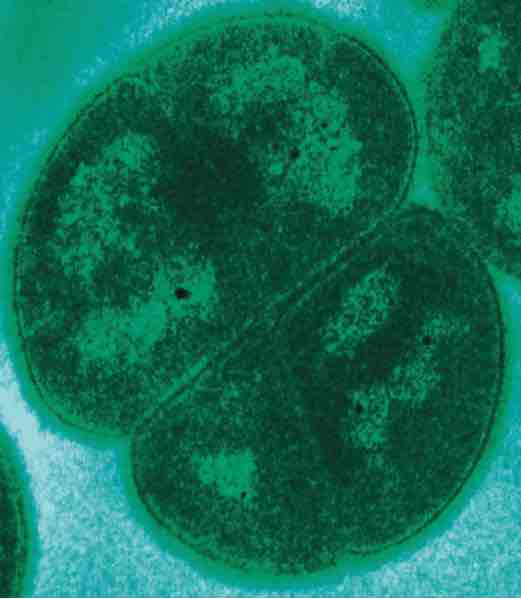The Deinococcus-Thermus are a small group of bacteria composed of cocci that are highly-resistant to environmental hazards. There are two main groups: the Deinococcales include two families, with three genera, Deinococcus and Truepera.
The Thermales include several genera resistant to heat (Marinithermus, Meiothermus, Oceanithermus, Thermus, Vulcanithermus).
Though these two groups evolved from a common ancestor, the two mechanisms of resistance appear to be largely independent.
DEINOCOCCUS
This is the one genus of three of the Deinococcales group from the Deinococcus-Thermus phylum, and is highly-resistant to environmental hazards. It has several species that are resistant to radiation (they have become famous for their ability to eat nuclear waste and other toxic materials), survive in the vacuum of space, and in extremes of heat and cold. There are 47 species of Deinococcus described according to NCBI on 25 August 2011.
These bacteria have thick cell walls that give them Gram-positive stains, but they include a second membrane and so are closer in structure to those of Gram-negative bacteria. Cavalier-Smith calls this clade Hadobacteria (from Hades, the Greek underworld).
They are also characterized by the presence of the carotenoid pigment Deinoxanthin that give them their pink color, and a high resistance to gamma and UV radiation. They are usually isolated according to these two criteria.
D. RADIODURANS
Deinococcus radiodurans is an extremophilic bacterium, one of the most radioresistant organisms known. It can survive cold, dehydration, vacuum, and acid, and is therefore known as a polyextremophile and has been listed as the world's toughest bacterium in The Guinness Book of World Records.
D. radiodurans is a rather large, spherical bacterium, with a diameter of 1.5 to 3.5 µm. Four cells normally stick together, forming a tetrad . The bacteria are easily cultured and do not appear to cause disease. Colonies are smooth, convex, and pink to red in color. D. radiodurans does not form endospores and is nonmotile. It is an obligate aerobic chemoorganoheterotroph, i.e., it uses oxygen to derive energy from organic compounds in its environment.
It is often found in habitats rich in organic materials, such as soil, feces, meat, or sewage, but has also been isolated from dried foods, room dust, medical instruments and textiles. It is extremely resistant to ionizing radiation, ultraviolet light, desiccation, and oxidizing and electrophilic agents.
Its genome consists of two circular chromosomes, one 2.65 million base pairs long and the other 412 thousand base pairs long, as well as a megaplasmid of 177 thousand base pairs and a plasmid of 46 thousand base pairs. It has about 3,195 genes. In its stationary phase, each bacterial cell contains four copies of this genome; when rapidly multiplying, this increases to eight to 10 copies.
D. radiodurans is capable of withstanding an acute dose of five thousand Gy (five hundred thousand rad) of ionizing radiation with almost no loss of viability, and an acute dose of 15 thousand Gy with 37% viability. A dose of five thousand Gy is estimated to introduce several hundred double-strand breaks (DSBs) into the organism's DNA (~0.005 DSB/Gy/Mbp (haploid genome)). For comparison, a chest X-ray or Apollo mission involves about one mGy, five Gy can kill a human, two to eight hundred Gy will kill E. coli, and over four thousand Gy will kill the radiation-resistant tardigrade.
Several bacteria of comparable radioresistance are now known, including some species of the genus Chroococcidiopsis (phylum cyanobacteria) and some species of Rubrobacter (phylum actinobacteria); among the archaea, the species Thermococcus gammatolerans shows comparable radioresistance.
D. radiodurans also has a unique ability to repair damaged DNA. It isolates the damaged segments in a controlled area and repairs it. This bacteria can also repair many small fragments from an entire chromosome.
THERMUS
A genus of thermophilic bacteria that can tolerate high temperatures, it is one of several bacteria belonging to the Deinococcus-Thermus group and includes the following three species: T. aquaticus, T. antranikianii, and T. igniterrae.
Thermus aquaticus is the source of the heat-resistant enzyme Taq DNA polymerase, one of the most important enzymes in molecular biology because of its use in the polymerase chain reaction (PCR) DNA-amplification technique.
It thrives at 70°C (160°F), but can survive at temperatures of 50°C to 80°C (120°F to 175°F). This bacterium is a chemotroph — it performs chemosynthesis to obtain food. However, since its range of temperature overlaps somewhat with that of the photosynthetic cyanobacteria that share its ideal environment, it is sometimes found living jointly with its neighbors, obtaining energy for growth from their photosynthesis.

Thermus aquaticus
Electron microscopy of thermus aquaticus.

A tetrad of D. radiodurans
Transmission electron microgragh (TEM) of D. radiodurans.